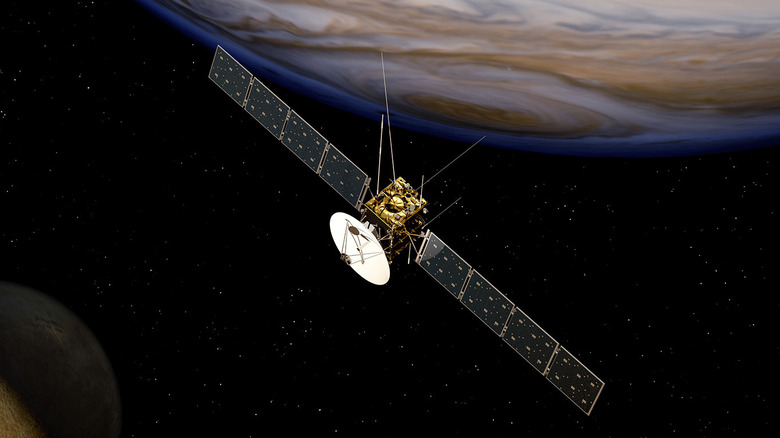Here's The Plan For Europe's Juice Mission To Jupiter
Jupiter will soon be getting a new visitor: along with NASA's Juno spacecraft, currently orbiting the planet, the European Space Agency (ESA) will be sending its Juice mission there next year. The mission, the name of which stands for Jupiter Icy Moons Explorer, is scheduled for launch in 2023 and arrival at Jupiter in 2031. The ESA has released an animation showing Juice's journey, and how it will visit not only Jupiter but also the three of the largest of the planet's more than 80 moons. To get to Jupiter, the spacecraft will get some help along the way; it will fly close by multiple planets in the inner solar system in maneuvers which will propel it on its journey called gravity assist flybys.
These include flybys of Earth in 2024, Venus in 2025, and back to Earth twice in 2026 and 2029. The first Earth flyby is unusual in that it won't only use Earth's gravity but also the moon's, in a maneuver called a Lunar-Earth gravity assist. According to ESA, this is the first time such an maneuver will be attempted; performing this operation — a gravity assist flyby of the Moon followed 1.5 days later by one of Earth — will save a significant amount of propellant. After its arrival at the Jupiter system in 2031, the spacecraft will orbit the planet Jupiter as well as performing flybys of the moons Europa, Callisto, and Ganymede. Finally, it will go into orbit around Ganymede before it runs out of fuel and ends its mission by impacting into Ganymede's surface in 2035.
Launching to Jupiter
The Juice mission will be launched using an Ariane 5 rocket from Europe's Spaceport in Kourou, French Guiana (via ESA). The idea is to study Jupiter and its moons, in part to learn about whether habitable worlds could be found orbiting gas giant planets beyond our solar system. Gas giants are some of the most commonly identified exoplanets, so finding that they could support habitable worlds would open new avenues for searching for life elsewhere in the universe.
Europa is a particularly intriguing target in the search for habitable worlds because it is thought to have a liquid ocean beneath an icy crust, and water is a key requirement for life as we know it. To investigate further, Juice will perform two flybys to look at both its surface composition and to search for pockets of liquid water beneath its surface. It will also look at the moon's atmosphere and investigate the plumes of water which previous missions have spotted emanating from its surface. Callisto may also harbor an ocean beneath its surface — though there is less evidence of this — so Juice will study it in more detail as well. Finally, Ganymede is of great interest because it is the only known moon in the solar system to have its own magnetosphere. Juice will orbit Ganymede to discover more, becoming the first spacecraft to orbit the moon of another planet.
